
Klim Badlands Pro A3 Review: The Best ADV Suit?
left for contents
Riding through all kinds of weather and terrain is what adventure motorcycling is all about. After a rough spill, I realized that having the right gear can make all the difference, not just in comfort but in safety. Enter the Klim Badlands Pro A3, the latest offering from a brand known for pushing the boundaries of motorcycle apparel.
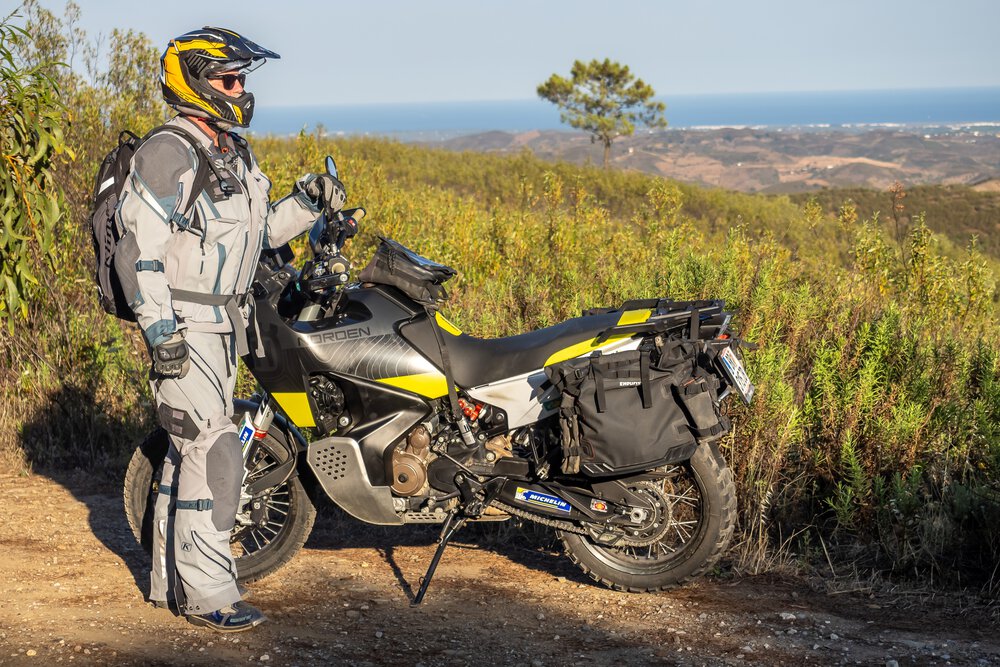
I tested the Klim Badlands Pro A3, both jacket and pants, on a six-week adventure ride across Europe. Here’s what I found:
- Its versatility for different weather conditions is superb; a rare trait even for an adventure suit.
- Its protection level is second to none in the adventure gear category. Unless you want to wear MotoGP leathers on the trails, it doesn’t get better than the Badlands Pro A3.
- This suit includes it all: no need to layer abrasion protection over impact protection. That’s a HUGE convenience when out on a long adventure ride.
- The price is indeed steep; but a lot cheaper than a hospital visit (and I have the receipts to prove it).
- This suit looks the part – but for that, pictures are a thousand words.
The Klim Badlands Pro A3 has everything you need from an adventure suit: rugged protection, versatility to fit any conditions, comfort for long days, and endless customization. This is the best adventure jacket on the market. | Perfectly suited for any adventure ride, from long hours on the highway to hard enduro in the backwoods. Ride in comfort anywhere from the deserts of Morocco to the jungles of Vietnam. |
The Klim Badlands Pro A3 has everything you need from an adventure suit: rugged protection, versatility to fit any conditions, comfort for long days, and endless customization. This is the best adventure jacket on the market.
Perfectly suited for any adventure ride, from long hours on the highway to hard enduro in the backwoods. Ride in comfort anywhere from the deserts of Morocco to the jungles of Vietnam.
Editor's Tip: Want a set of back, chest and shoulder protection that absorbs 50x more impact than even the Klim Badlands? Pick up an Alpinestars Tech Air Off-Road Airbag! Two gas canisters for two separate deployments (great for long days on the trail), and you can replace canisters yourself. Your ribs will thank you later.
A New Standard in Adventure Riding Gear
When Klim launched the Badlands Pro A3 Jacket and Pants, they set a new benchmark for Adventure gear in several ways, from the first CE AAA-rated garment (same level as modern track leathers) featuring GORE-TEX waterproofing to a kidney belt system to keep the weight of the garment (and pockets contents) off the riders shoulders.
Keep these in mind as you consider whether the Klim Badlands Pro A3 is for you.


Key Elements:
- Material Composition: 3-Layer GORE-TEX Pro Shell, Vectran, CORDURA, SuperFabric, leather (more on these materials further in the article). Lining is Klimatek cooling mesh that’s moisture-wicking and breathable.
- Armor: D3O CE Level 2 that’s vented for airflow (Klim Aero Pro) at the elbows, shoulders, knees and hips. You also get a D3O CE Level 2 back pad (Viper Pro) AND tailbone pad. Chest pads are also included, made from thin sheets of Poron XRD impact protection foam, but they aren’t CE rated unfortunately. I replaced them with D3O CE Level 1 chest pads separately available from Klim.
- Ventilation: 18 vents in total, 12 on the jacket and 6 on the pants. You can go from all-mesh airflow to parka insulation and everything in between.
- Storage: Jacket has 10 external and 4 internal pockets as well as a hydration bladder pocket in the back. Pants have just 2 large cargo pockets. More than I’ve ever seen on an adventure suit.
- Fit: Slack and roomy, just as you want from an adventure suit. However, you have several cinch cords and adjustment points to hold the sleeves and waist in place, and a kidney belt inside to support the weight of the jacket, pocket contents, and hydration bladder.
What I Love:
- Similar protection as a race suit: This suit is rated to withstand 75 mph slides on asphalt (CE AAA) and has the top impact protection rating in the industry (CE Level 2) on almost all pieces of armor included.
- Best waterproofing available on any garment: 3-layer GORE-TEX Pro. This isn’t just rare on motorcycle gear, it’s rare on any kind of outdoor gear.
- Trail and adventure ready: With all-season versatility, tons of storage and customizable ventilation this jacket will suit you well whether you’re riding frigid trails in Vancouver, crossing the deserts of Morocco or slipping through the jungles of Thailand.
- Exceptional comfort: The kidney belt and adjusters available all around
- Guaranteed crash damage replacement: if you’re a hard rider, this will more than pay for itself, and makes the price tag easier to stomach.
What I Don’t Like:
- Weight: The kidney belt helps here, but the Badlands is still a heavy piece of kit compared to lighter armor-only suits you might wear in hot weather for purely off-road riding.
- Hydration bladder not included: Maybe I’m nitpicking, but this seems like a strange omission on such a premium piece of gear. However, this does allow you to buy the exact model you like and insert it, e.g., the Klim Hydrapak available in 2L and 3L volume.
- Kidney belt retention system: As it’s elastic, the kidney belt automatically retracts upon releasing the Velcro closure into a storage compartment in the liner of the jacket. The triple retention tabs sewn onto both ends of the belt sometimes don’t catch onto the holding straps to prevent the belt from retracting completely into its sleeve, requiring to ‘fish’ it out again.
- Price tag: The Badlands Pro A3 is a premium suit with a premium price to match – that said, it might save you in hospital bills (or worse) down the line. Keep in mind that the price includes a crash replacement warranty, which is a major bonus.
Let’s get into my impressions and review of this suit over my six-week ride in Europe, starting with what I was looking for and then going through the finer points of this jacket and pants set.
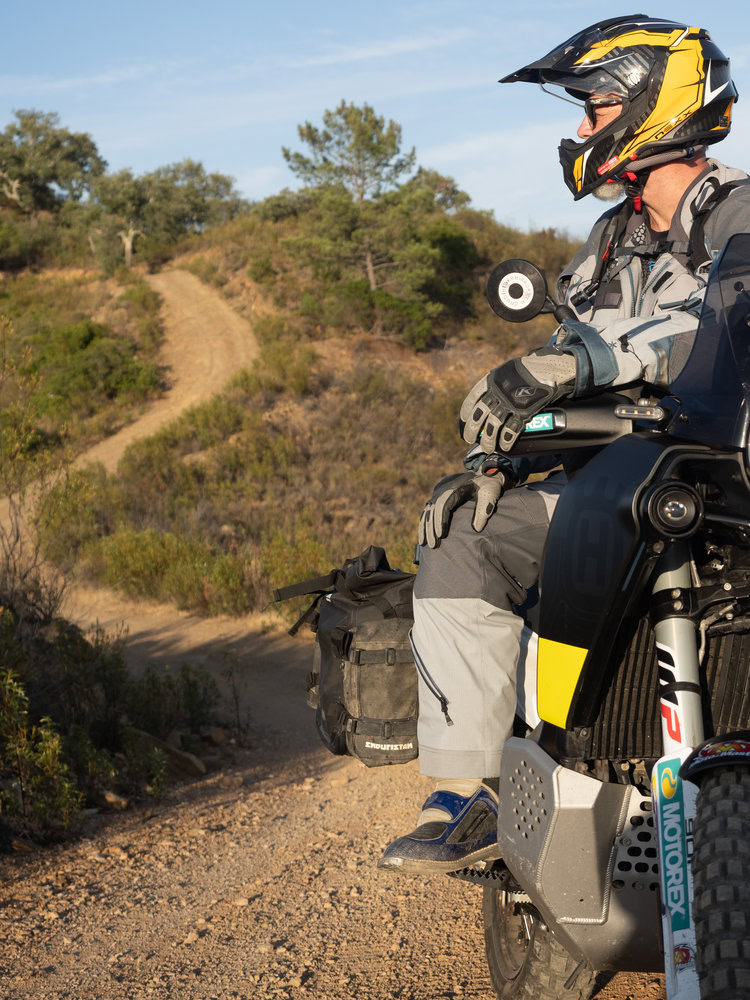
What I Was Looking For in Technical Riding Gear
After my recent crash, I was looking first and foremost for the best protection available in an adventure suit. Although I’m predominantly an off-road rider, riding stretches of pavement is unavoidable on my multi-week/month-long ADV journeys. So I wanted a suit that could flex between not only different climates but different riding conditions as well.
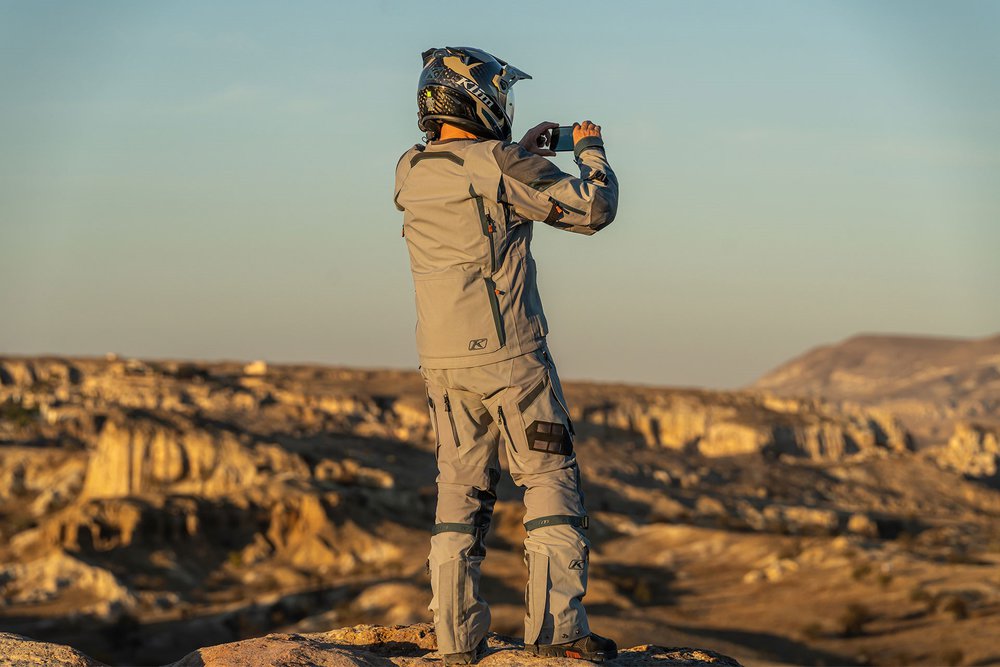
I only considered gear with CE Level 2 protectors, since I’m not a huge fan of breaking bones. For the outer shell, I was looking for technical fabric that could withstand the rigors of trail riding – from thorns to sharp rocks – without ripping. Abrasion resistance was a top priority aimed at protecting my skin in the event of a spill on pavement. CE AAA abrasion resistance is the gold standard here.

The final piece I was looking for in regards to protection is quality workmanship. This can be easy to overlook at the sight of a bargain price tag, but, in my experience, it is equally important to those safety ratings above.
Sturdy seams, ideally triple-stitched, with high-tensile strength thread are a must. Even with strong material a jacket can be peeled open like a banana and rendered useless if the seams are too weak to hold up in a real-life crash.
Klim hit all these marks with flying colors on the Badlands Pro A3 suit. Not only did it receive a CE AAA rating certified to Europe’s rigorous EN17092-2 standard, it’s the first-ever garment to do that while incorporating GORE-TEX waterproofing.
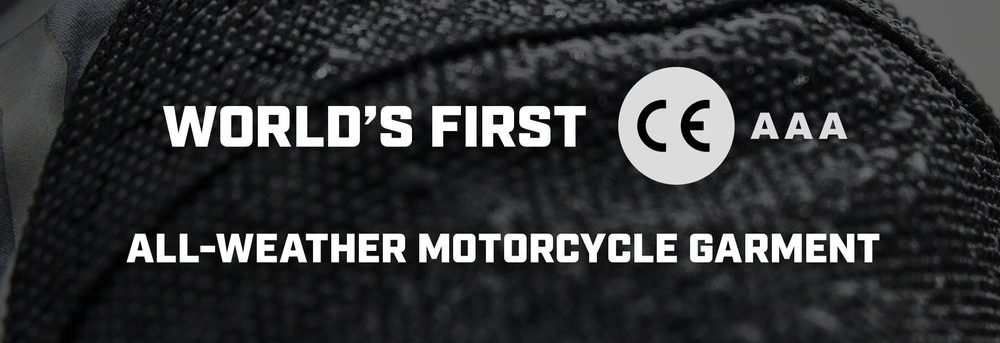
Before I get into the next aspect I was looking for – versatility – a quick aside on safety ratings. You can skip this by clicking here.
A Quick Overview of CE AAA and the CE EN17092 Safety Ratings
Let me walk you through the word salad of European safety ratings, in case you aren’t familiar. The EN17092 is the harmonized CE standard for motorcycle clothing. “CE” stands for “Conformité Européenne” (European Conformity in French), which governs the safety ratings for Personal Protective Equipment (PPE) for various industries and uses, from electronics to motorcycle gear. The CE certification system is known for being the most comprehensive and rigorous in testing and rating a wide range of products and materials.
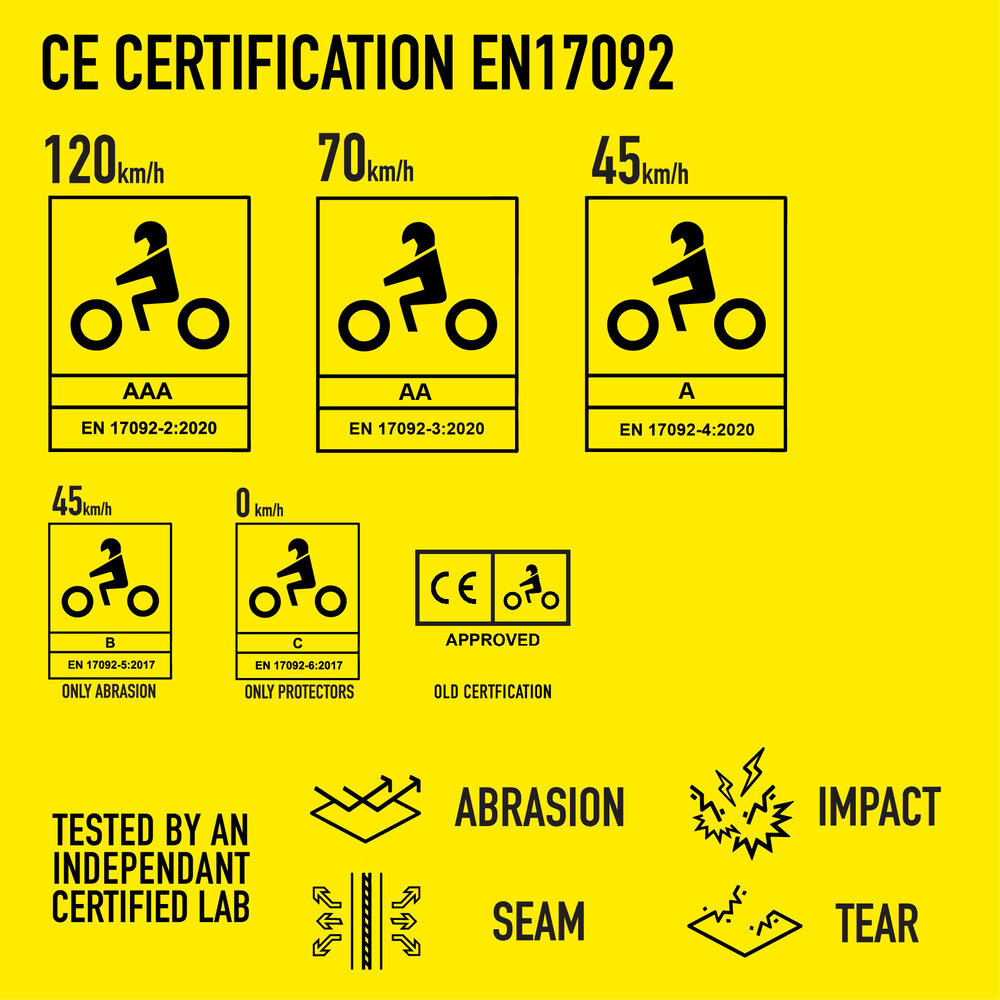
Under EN17092, products are classified into five rating categories: AAA, AA, A, B, and C. The A-class rates gear based on a combination of abrasion and impact protection, while B and C-class ratings focus solely on abrasion resistance and impact protectors, respectively.
| CE certification EN 17902-2:2020 | Certification Class | Protection Limit | |
| AAA | Abrasion & Impact Protection | 120 km/h | 75 mph |
| AA | Abrasion & Impact Protection | 70 km/h | 43.5 mph |
| A | Abrasion & Impact Protection | 45 km/h | 28 mph |
| B | Only Abrasion Protection | 45 km/h | 28 mph |
| C Level 1 | Only Impact Protection | 18 kN | |
| C Level 2 | Only Impact Protection | 9 kN | |
The C-class for impact protection armor is divided into two levels: Level 1, where the maximum force transmitted upon impact cannot exceed 18 kN, and Level 2, limiting the force to no more than 9 kN transferred through the material. Learn more about what these ratings mean in our article on motorcycle body armor.
The regulation further categorizes the body into three zones of risk for impact and abrasion, from the highest risk (Zone 1) to lower-risk areas (Zone 3). For Zone 1, think elbows, shoulders, hips, and knees. For For Zone 3, think chest and inner thighs.

The CE AAA certification is the highest rating achievable for impact and abrasion protection, typically found in leather racing suits and advanced base layers like the BOWTEX Elite made from innovative materials. However, none of these AAA-certified garments include the highly sought-after GORE-TEX label.
Versatility is King in Adventure Gear
Beyond protection, I wanted to find an adventure suit that was truly versatile.
I’m thankful that the rise in popularity of adventure (ADV) and dual-sport (DS) motorcycling has brought new and old manufacturers into the market to innovate on gear. However, still relatively few brands build excellent adventure gear. The key word here is ‘excellent’.
All of their failures hinge on one missing element: versatility.
Adventuring is inherently unpredictable. An adventure rider might go out for a day ride in the desert, only to find a flat tire keeps them there until late at night – when temperatures drop to frigid levels.
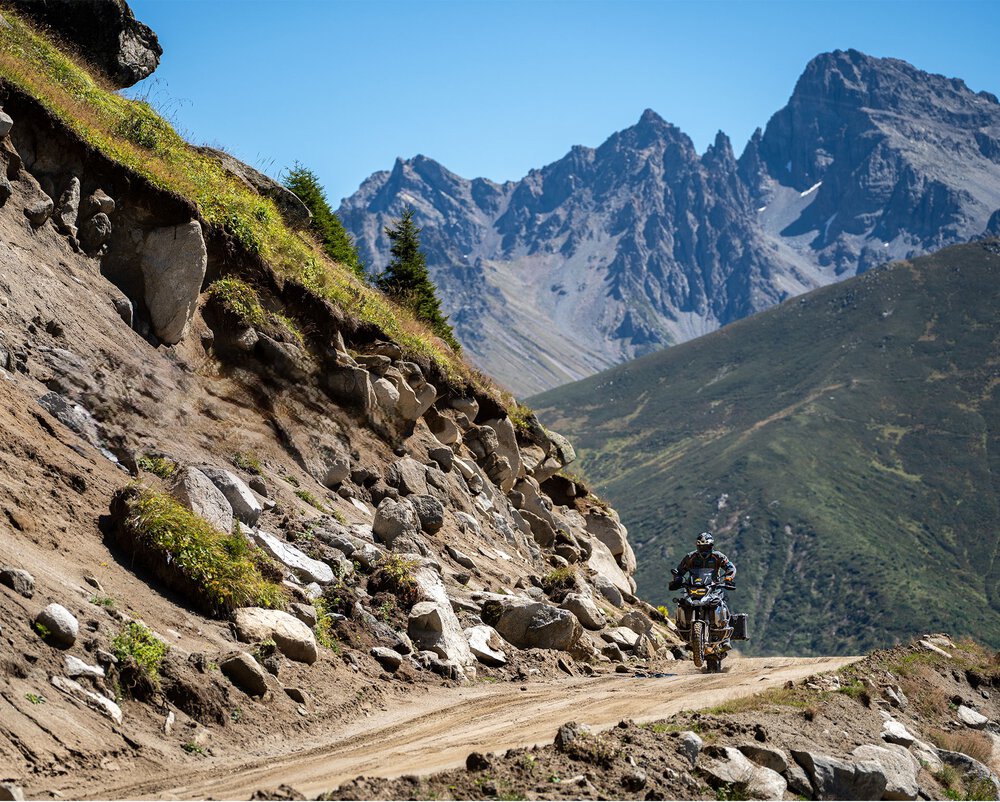
Planning for adventure means planning for anything. And this is where purpose-built motorcycle gear always fails to do the job. Adventure gear must flex from sticky hot asphalt cruising to rainy conditions in the jungle, to wiping out on sands and rocks, to freezing rain in the mountains. It must be comfortable for long highway rides at high speeds and slow, grueling peg-standing workouts climbing rough single track trails.
This may be part of the reason ADV gear is becoming so popular: one piece of gear can suffice for many conditions and types of riding. That’s saved money, space, and time.
It’s for these reasons that creating a standout piece of adventure gear is the pinnacle of motorcycle gear design, in my opinion. Manufacturers that build a great piece of adventure gear must demonstrate their knowledge of rider needs, comforts, and protection in all situations.

Klim: A Legacy of Innovation
Klim’s reputation for quality didn’t appear overnight. From their humble beginnings in Idaho to becoming a household name in the adventure riding community, Klim’s “No Compromise” approach to quality appealed to me from the time I bought their first pair of off-road pants in 2004. They’ve continued to push the envelope in technical garments for off-road and adventure motorcycle riders ever since.
The Badlands Pro line, introduced in 2011, quickly became a favorite among serious riders. But Klim didn’t just sit back in the saddle and count their cash.
The Badlands Pro A3 is a key example of Klim’s relentless innovation – even as the market leader, they continue to set higher standards. The collaboration with material suppliers to achieve the BLP A3’s CE AAA rating with GORE-TEX waterproofing is a testament to Klim’s commitment to keep building better gear.
So what is it about riding in the A3 suit that impressed me so much?
Klim Badlands Pro A3: The New Standard in Adventure?
Klim doesn’t just stuff the Badlands Pro A3 full of buzzwords – they studied the needs of adventure riders to create a tougher, lighter and more durable garment for all types of rides and intensity levels.
Klim’s latest flagship ADV combo has set a new benchmark for high-end adventure riding gear. The Badlands Pro A3 isn’t just about looking tough; it’s about being tough, with advanced design and cutting-edge fabric technology.

Thanks to a mix of innovative materials and a smarter design, this suit is stronger, lighter, and more resistant to cuts and abrasions than any other ADV gear out there. It’s not just hype—this has been confirmed by Klim, my own testing, and the impressive CE AAA rating.
Breaking the CE AAA Barrier
So why hadn’t any GORE-TEX ADV gear hit the AAA mark before? Was the competition just not trying hard enough? Or was it that no fabric had yet managed to combine maximum protection with enough breathability to meet GORE-TEX’s stringent standards?
The challenge wasn’t just about making a super protective suit; it was about creating one that also allowed enough breathability for the GORE-TEX membrane to do its job. Without proper breathability, the membrane can’t effectively let water vapor escape, which is a dealbreaker for GORE-TEX certification.
You see, a brand can’t just throw a GORE-TEX label on to anything – that garment must be tested by the GORE-TEX team to certify that it breathes enough air to be considered worthy of the tag.
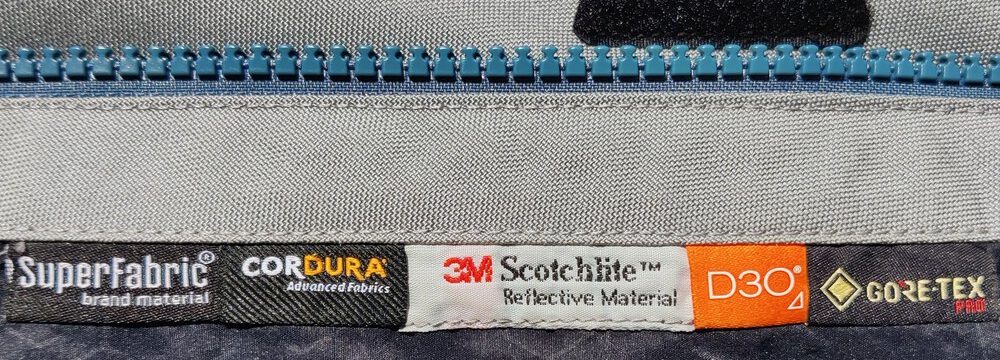
Klim took on this challenge head-on, working closely with their suppliers to develop state-of-the-art materials. They had previously partnered with the makers of CORDURA, SuperFabric, D3O, and 3M Scotchlite for the production of the CORDURA-chassis CE AA-certified Klim Badlands Pro, which remains available in Klim’s catalog as the more budget-friendly alternative to the top-of-the-line VECTRAN-chassis CE AAA-certified Badlands Pro A3. Both versions are identical in terms of layout and features, they only differ in the main outer shell fabric that makes up the chassis, namely CORDURA versus VECTRAN.

However, a heavy-duty CORDURA fabric that’s sufficiently thick to achieve AAA abrasion resistance certification wouldn’t breathe enough for the GORE-TEX membrane to function adequately, i.e., to let sweat evaporate. To remediate the lack of breathability, Klim resorted to using VECTRAN instead of CORDURA as the main outer shell material for the Badlands Pro A3.

VECTRAN is an exceptionally strong fabric woven from a high-tensile-strength multifilament polyester yarn spun from a liquid-crystal polymer. The result? A suit that not only meets, but exceeds the toughest tests out there while still providing waterproofing and breathability worthy of the GORE-TEX name and the coveted CE AAA rating.
The Price of Excellence
Now, let’s talk about the elephant in the room—the price.
Before I reveal it, you should know the price includes a replacement guarantee for gear damaged in a crash. Klim stands by that guarantee, and as far as I know no other brand offers this.
The Badlands Pro A3 doesn’t come cheap, with an MSRP of $1,500 for the jacket and $970 for the pants. It’s a big investment, sure, but when you find yourself sliding across asphalt, the last thing you’ll be thinking about is the money you saved by skimping on gear. And when you’re done sliding, you’ll be glad you invested in the most protective ADV suit on the market.
But the inclusion of the crash replacement warranty makes the hefty price tag a lot more acceptable. Although no one ever wants to send in a crash replacement warranty claim, knowing it’s part of the deal is reassuring for several reasons. Firstly, it indicates that Klim is confident that the VECTRAN chassis and SuperFabric armor will hold up in most crash scenarios without incurring damage. Otherwise, it wouldn’t be financially sustainable for Klim. Secondly, if the suit is to a large extent indestructible, it means it offers you maximum protection. Thirdly, if the suit does suffer damage, the replacement warranty will save you a lot of money.
So what did I put this suit through in order to make these claims?
Putting the Badlands Pro A3 to the Test
To really put this suit through its paces, I packed it up and headed to Spain for a 6-week adventure across Europe’s most challenging terrains. Riding a Husqvarna Norden 901, I traversed the Sierra Nevada mountains, crossed the Algarve, and pushed north through the Pyrenees and the Alps. It was the perfect testing ground for the Badlands Pro A3, offering a mix of climates and conditions that truly challenged the gear.
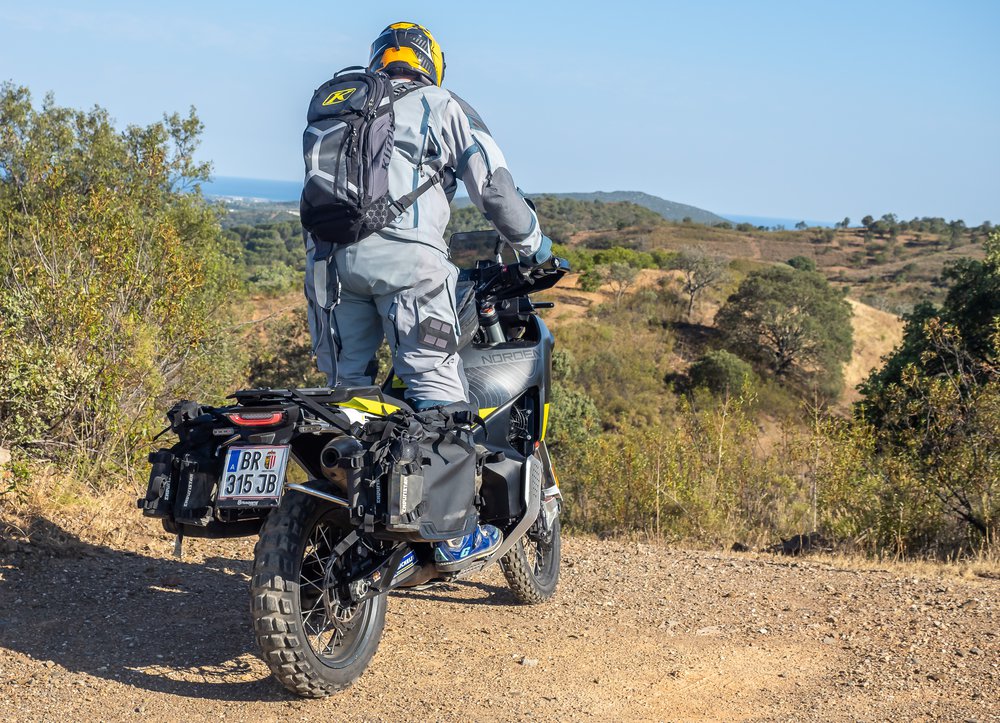
And yes, my orthopedic surgeon gave me the green light, with a gentle reminder to go easy—a request my wife echoed, considering my last test ride in Thailand ended less than gracefully.
Collecting the bike from Lyndon Poskitt, a Dakar Rally legend and Klim and Husqvarna ambassador, I set off from Malaga through the Sierra Nevadas in Andalusia. I had already explored the Trans Euro Trail (TET) network in France and Spain last year, so I opted to take the Adventure Country Tracks (ACT) in Portugal and the Pyrenees this year. This network is similar to the Backcountry Discovery Routes (BDR) in the USA – both of which should be high on your bucket list.
During my downtime on the trails, I researched more deeply into the specs of the suit I was wearing, from that VECTRAN outer shell to the SuperFabric abrasion zones and GORE-TEX layering. Here’s what I found.
Specs VS Reality: Klim Badlands Pro A3
The Klim Badlands Pro A3 talks a big game – and I found it delivers even more. Let’s start with the shell.
The shell and construction of the jacket and pants are about as detailed as it gets with motorcycle gear.
The 3-Layer GORE-TEX Pro shell construction consists of the expanded PTFE membrane-backed VECTRAN, reinforced with ceramic SuperFabric abrasion zones on shoulders, elbows, forearms, and knees. You also get leather on the inner knees for better tank grip on the trails.


VECTRAN fabric all around provides CE AAA-certified abrasion resistance (more on this below). All the details are finished perfectly, from 3M Scotchlite reflectors to YKK water-resistant zippers (double headed on the front zipper) and leather trim on the cuffs.
So how does this word salad perform in the real world?
Let’s start with the waterproofing: I rode in pouring rain for hours – had there been a leak, I would have felt it with the cold alpine winds blowing across my bike. Thankfully, the 3-Layer GORE-TEX Pro construction and YKK waterproof zippers did their job flawlessly.

Klim is not selling you a marketing slogan here – the Badlands Pro A3 really does seal out the rain, without sealing in body heat and moisture. This is a remarkable achievement, given the jacket alone has 20 external zippers across vents and pockets, each with a hood at their termination point to keep even a dash of water from getting in.

The GORE-TEX Pro 3-Layer Shell is a marvel of engineering – laminated together it moves like one layer, but allows the garment to seal out water while allowing moisture to wick away from the rider. There’s nothing as frustrating as the choice between getting wet from rain or wet from your own sticky sweat – most waterproof jackets only provide these two choices. The Badlands Pro A3 provides a third way – cool, dry, and comfortable in even the most wicked of storms.
How about the materials on this suit – from SuperFabric to Vectran?
SuperFabric is a fascinating technology that applies perfectly for the needs of adventure riders hitting asphalt and trails. SuperFabric is a hi-tech hybrid material, taking advantage of the breathability and flexibility of a base layer loaded with a dense field of tiny round ceramic dots printed onto the base layer.

These ceramic dots are astronomically harder than any fabric material – even leather. Imagine taking an industrial sander to a sample of leather and a piece of rock – which one will take more damage?
SuperFabric gives you the wearability of a fabric with the abrasion resistance of a rock. It’s 10 to 15 times more abrasion resistant than aramid (Kevlar) and 5 times that of racing-grade leather.
The leather used on the inside of the knees on the Badlands Pro A3 is another testament to Klim’s knowledge of rider needs. Synthetic fabrics just don’t have the sticky gripping power (or heat resistance) of natural leather, so these patches allow the rider superior tank grip and bike control (without engine/exhaust pipe burns) when up on the pegs in tough off-road adventuring.

Now to VECTRAN. The more affordable, original CE AA-certified Badlands Pro, Klim’s best-selling ADV suit which remains part of the catalog, utilizes CORDURA, a high-tenacity nylon fabric commonly used in various thicknesses in motorcycle textile gear construction.
The VECTRAN fabric, used for the top-of-the-line CE AAA-certified Badlands Pro A3, improves on CORDURA significantly in that it is thinner, lighter, more flexible, and more abrasion/slash/tear resistant – all very important traits in adventure gear construction.
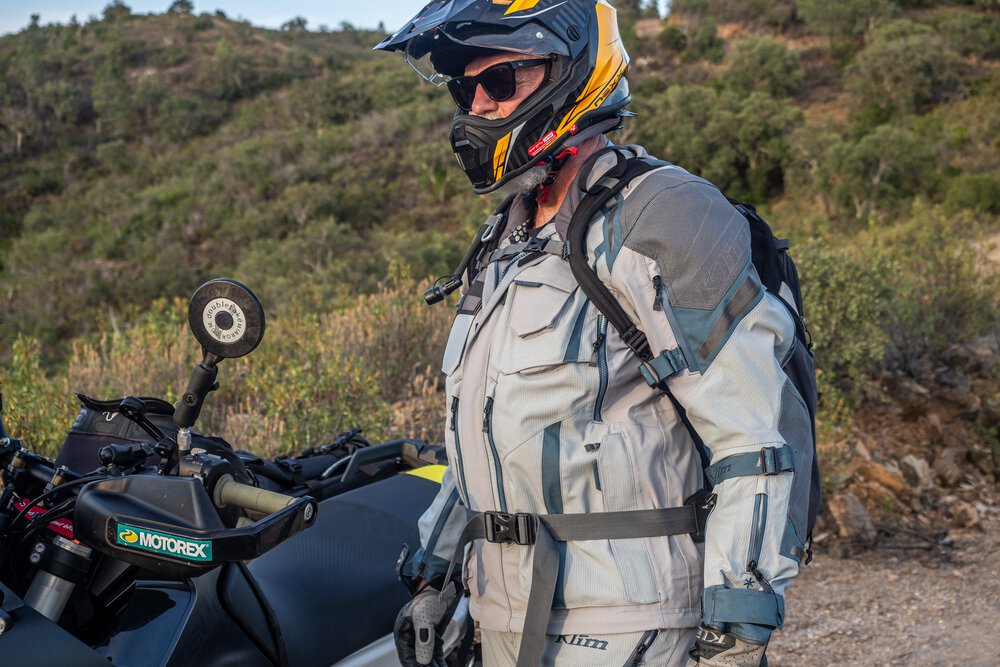
What is VECTRAN? Compared to popular high-performance materials CORDURA and KEVLAR, it’s a technologically superior fabric made of polyester spun from a liquid-crystal polymer. So, how, and to what extent, does VECTRAN’s performance exceed that of CORDURA and KEVLAR? To do this, let’s look at the defining characteristics of each material, and see how they compare.
CORDURA is a high-performance, synthetic fiber-based fabric renowned for its durability and resistance to abrasions, slashes, tears, and scuffs. Made from nylon, it’s widely used in the production of outdoors and performance apparel and gear, like luggage, backpacks, motorcycle apparel, military clothing, etc.
KEVLAR started being applied for motorcycling apparel in the early 1990s. KEVLAR is the trademarked name for an aramid fiber made by DuPont. Aramid is the general name for an aromatic polyamide fiber with an extremely high tensile strength and a high strength-to-weight ratio – making it a popular choice for stopping punctures. Think bulletproof vests.
VECTRAN has the same tensile strength as aramid (Kevlar) but it is 3x more abrasion resistant. It combines cut/puncture resistance with abrasion resistance. It’s also more resistant to moisture and acidic and alkaline compounds than Cordura – meaning more durable despite the elements.
Klim backs up their material design with a crash damage replacement guarantee. Damage the Badlands Pro A3 in a crash and they will replace it free of charge. They clearly believe in its durability, or that guarantee would cost them too much to back it.
Armor in the Klim Badlands Pro A3
When it comes to adventure riding, protection is paramount. The Klim Badlands Pro A3 takes this seriously with its top-notch armor system, designed to keep you safe without sacrificing comfort or mobility. Let’s dive into what makes this suit’s armor so impressive.
The Badlands Pro A3 is equipped with KLIM AERO PRO D3O CE Level 2 armor, offering high-level protection across various points of the body. This isn’t your run-of-the-mill foam padding; it’s a polymer suspended in liquid lubricant that turns hammer strikes into nudges.

Jacket Armor Highlights:
- Shoulder Armor: KLIM AERO PRO D3O CE Level 2 vented
- Elbow Armor: KLIM AERO PRO D3O CE Level 2 vented
- Back Protection: D3O Viper Pro CE Level 2 back pad, vented
- Chest Pads: Comes standard with perforated XRD Impact Protection Foam, but can be upgraded to D3O CE Level 1 split chest pads for even better protection.
- Additional Features: Includes a kidney belt with easy access ports for adjustments and stowing.
Pants Armor Highlights:
- Hip Armor: KLIM AERO PRO D3O CE Level 2 vented
- Knee Armor: KLIM AERO PRO D3O CE Level 2 vented and adjustable
- Tailbone / Coccyx Protection: KLIM AERO PRO D3O CE Level 2 armor
Why D3O Armor Beats Foam Every Time
D3O is not your typical foam padding; it’s a non-Newtonian material, meaning it’s soft and flexible during regular use but hardens upon impact to absorb and dissipate energy. This technology drastically reduces the force transmitted to your body, making it one of the best materials for impact protection.

The D3O Aero Pro armor has been specially developed for the Badlands Pro A3 to meet the breathability requirements set out by GORE-TEX. The open structure with large holes offers five times more ventilation than the widely-used standard options, without compromising protection.

These new designs ensure that even with top-tier protection, you stay comfortable and cool. The armor is limb- and side-specific, optimizing coverage and stability during a fall. With internal mesh pockets and Velcro strips at the knees and elbows, you can easily adjust the positioning of the armor to fit your body perfectly.
Why the Armor Matters
In my own rigorous testing, I found the D3O armor not only met but exceeded my expectations. The Level 2 certification is the highest CE rating for impact protectors, and the D3O pads specifically developed for the Klim Badlands Pro A3 provide 44% more coverage than the standard options. Despite their size and thickness, the pads are surprisingly lightweight, thanks to extensive ventilation holes.
And yes, I’ve tested this armor in an unceremonious get-off.

Let’s just say that my unscheduled test confirmed that the D3O armor does its job impeccably. The gear took the brunt of the impact, leaving the prosthetic received after my previous crash in Thailand intact. My fall was a replica of the one that landed me in a Thai hospital, but the impact absorbtion property of the protective D3O pads kept me out of the operation theater this time.
As I had fallen on my recently reconstructed upper and lower limbs, I feared for a moment that I might have damaged my newly-fitted spare parts. But much to my surprise, I could move my limbs without feeling any pain. So, I got up and dusted myself off, lifted the bike up, and was on my way a few minutes later.
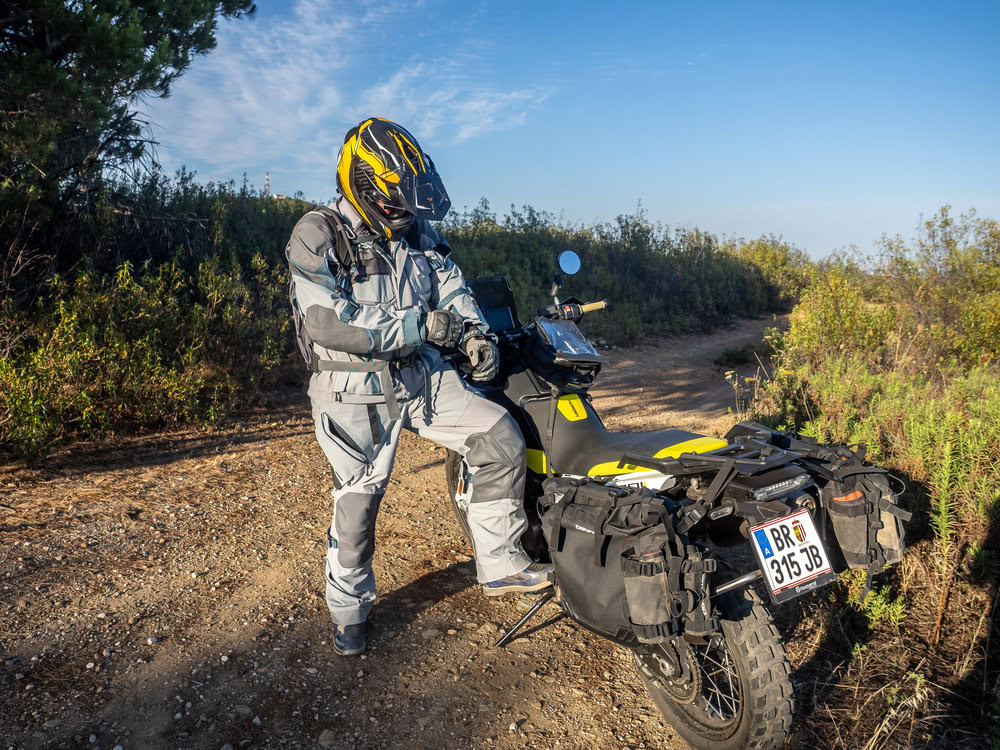
That evening, I inspected the impact zones on the jacket and pant, and much to my surprise I couldn’t see any scratches, let alone damage. The only sign of contact was some dirt that got stuck between the tiny ceramic dots of the SuperFabric on the impact zones. After cleaning off the dirt with a wet brush, it was impossible to tell that my suit had been scraping over asphalt and dirt. Later, I even used a magnifying glass to inspect the SuperFabric’s ceramic dots, but there was no sign of visible scratches.
Trust me, when you’re sliding along the pavement, the cost of the gear won’t enter your mind as it pales in comparison to the cost of surgery. Good gear pays for itself, and the Klim Badlands Pro A3 is no exception.
Ventilation in the Klim Badlands Pro A3
When you’re out on the road, facing changing weather and temperatures, the ability to regulate your body heat is crucial. The Klim Badlands Pro A3’s ventilation system was one of the aspects that stood out during my cross-Europe test travels. It is the best-ventilated four-season suit I’ve ever worn.
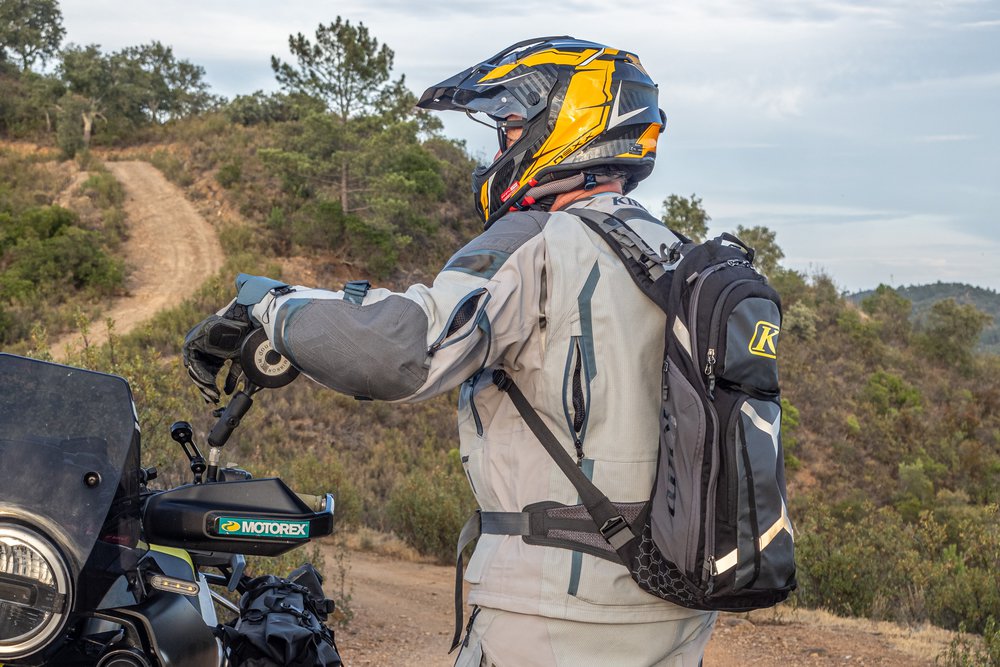
The Badlands Pro A3 is equipped with an extensive array of vents designed to keep you cool when things heat up and seal out the cold when the temperature drops. Here’s what you get:
Jacket Ventilation Features:
- Wrist Vents: Two massive adjustable wrist vents with dual zippers allow you to control the airflow up into your sleeves precisely where you need it around your lower arms.
- Core Vents: Four vents on the core, two of which can double as pockets, provide significant airflow around your torso.
- Bicep and Tricep Vents: Two intake vents on the biceps and two exhaust vents on the triceps ensure that air circulates effectively around your upper arms and arm pits.
- Back Exhaust Vents: Two vents on the back help to release hot air.
- Collar Tabs: A clever feature that allows you to keep the collar open, increasing airflow to the upper chest without the jacket flapping in the wind.
Pants Ventilation Features:
- Thigh Vents: Two intake vents on the thighs bring in cool air, while two exhaust vents release warm air.
- Lower Leg Vents: Additional side vents on the lower legs help to regulate temperature and provide further cooling.
Is All This Ventilation Overkill?
You might think that all these vents are overkill, but they are essential for adapting to varying conditions. On a hot day, you might not notice just how much air is flowing through the suit, but as the temperature drops, the strategic placement of these vents becomes apparent.
I noticed this clearly when riding up and down the mountain passes where temperatures were substantially cooler than in the valleys. The spacious fit of the Badlands Pro A3 ensures that air circulates freely around your torso and limbs, preventing any hot spots and keeping you comfortable.
Are these vents truly better than other adventure suits?
I’ve ridden in all kinds of weather across five continents over the past fifty years, and I can confidently say that the Badlands Pro A3 offers the best ventilation I’ve ever experienced in an all-weather, four-season riding suit. The collar tabs, for instance, are a simple yet effective way to enhance ventilation around the neck and chest, a feature that many other suits lack.

Klim’s designers deserve high praise for nailing the ventilation system on the Badlands Pro A3. It’s not just about keeping comfortable; it’s about regulating your body temperature and hence maintaining alertness and poise on the bike, no matter the weather conditions. This suit lets you ride in comfort and safety, knowing that you’re equipped to handle whatever the road or trail throws your way.
Storage Galore: The Klim Badlands Pro A3
One of the standout features of the Klim Badlands Pro A3 is its impressive storage capacity. If you’re the type of rider who likes to have everything at your fingertips, this suit has you covered.
Jacket Storage Features:
- Hand Cargo Pockets: Two water-resistant, gusseted hand pockets with internal organizer compartments make it easy to keep smaller items sorted and accessible.
- Napoleon Pocket: A waterproof, externally accessible pocket ideal for storing important documents or electronics.
- Chest Pockets: Two vertical gusseted chest pockets, two vertical core pockets (which can also function as vents), a chest utility pocket, and an external MOLLE-compatible panel provide a multitude of options for stowing gear. I attached my Garmin inReach Mini2 Satellite Communicator/Personal Locator Beacon to the MOLLE utility chest panel.
- Internal Pockets: Inside the jacket, you’ll find two lower zippered stash pockets and a vertical chest stash pocket, perfect for valuablesa and documents.
- Specialized Pockets: The forearm has an emergency ID stat card pocket, and there’s a concealed document pocket behind the back pad, useful to hide passport and bike registration. A large dual-access gusseted back pocket can hold bulkier items like a midlayer or gloves.
- Hydration Compatibility: An internal compartment for a hydration bladder, with routing options for the hose, keeps you hydrated on long rides.
Pants Storage Features:
- Cargo Pockets: Two large thigh cargo pockets with billowed design for extra capacity.
- MOLLE Panel: An external MOLLE-compatible thigh utility panel offers additional attachment options.
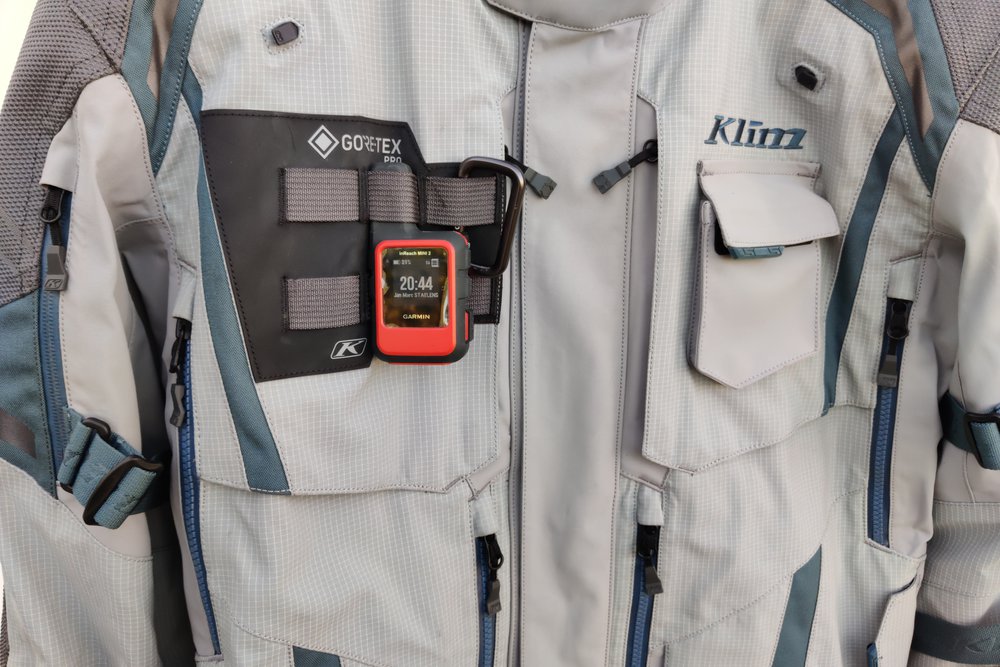
With a total of 16 pockets, the Klim Badlands Pro A3 has the storage capacity of a large daypack, allowing you to carry everything you want easy access to. Stuffed with a bunch of energy bars and snacks, phone, maps, ear plugs, sun glasses, lip chapstick, SPF cream, EDC multitool, sun hat, woollen beanie, pair of (rain) gloves, toilet tissue, wet wipes, and a Garmin inReach Mini 2 satellite communicator, my pockets still had plenty of storage capacity left. However, with so many pockets, it’s easy to lose track of where you’ve put things. It’s worth developing a system to keep everything organized.
Fit & Comfort: Built for All-Day Riding
Klim is renowned for its generous fit, designed to maximize comfort and versatility, especially crucial in ADV gear where mobility and adaptability are key.
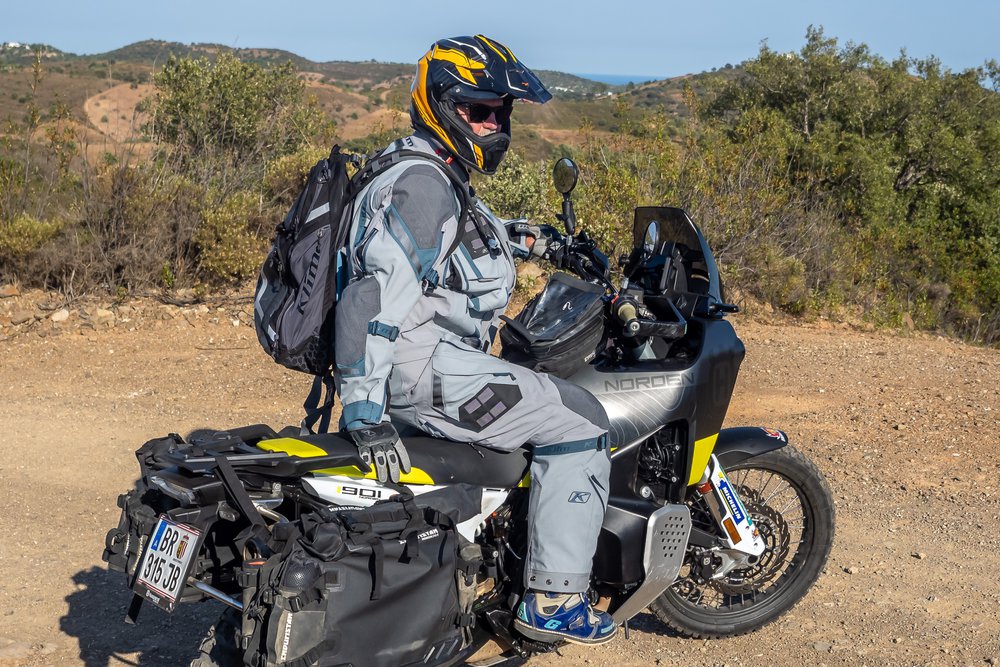
Jacket Fit & Comfort Features:
- Mobility Enhancements: Action-back gusseted shoulders and articulated seamless underarm gussets ensure freedom of movement.
- Comfort Liners: The jacket features a KLIMATEK cooling mesh full-sleeve liner and a moisture-wicking, breathable, antimicrobial mesh torso liner. The collar is lined with soft material for added comfort, and an adjustable cinch collar helps seal out the elements.
- Adjustability: Quick-adjust bicep and forearm straps, an adjustable bottom hem, and Velcro + zipper cuffs allow for a customized fit. The jacket-pant zip connection adds stability and protection as it prevents the jacket from riding up your back and exposing your skin when sliding across the pavement during a fall. This zippered connection helps to keep cold air out in combination with the integrated, removable kidney belt, which also provides lower back support.
- Layering Capability: The spacious fit allows for easy layering, ensuring you stay warm in colder conditions without feeling constricted.
Pants Fit & Comfort Features:
- Mobility & Comfort: An articulated seamless crotch gusset and KLIMATEK cooling mesh in the armor pad pockets and behind the knees enhance comfort and mobility. The moisture-wicking, breathable, antimicrobial mesh liner helps regulate temperature.
- Adjustability: Velcro adjustable waist straps, quick-adjust knee straps, and a zipper + snap adjustable bottom hem allow for a precise fit. The pants are designed to fit over off-road boots, making them versatile for different riding styles.
- Weather Protection: A waterproof front zipper gusset adds an extra layer of protection against the elements.
The roomy fit of the Klim Badlands Pro A3 isn’t just for comfort—it’s a practical design choice that enhances ventilation and allows for effective layering. The extra space between the suit and your body helps air circulate, keeping you cooler in warm conditions and allowing space for thermal layers in the cold. For inclement weather, the Klim Merino Wool Mid-Layer and Maverick Down Jacket are the perfect accompaniment for the Badlands Pro A3.
Color & Sizing Options
When it comes to adventure riding gear, fit is part of functionality. The Klim Badlands Pro A3 doesn’t disappoint, offering a broad range of sizes and colors to suit various preferences and body types.
Sizing Options:
- Jackets: Available in sizes SM, MD, LG, XL, 2X, and 3X, the jackets are designed to accommodate a wide range of body types.
- Pants: The pants offer even more flexibility with regular sizes (30 to 42), short options (30 to 40), and tall sizes (32 to 38).
Color Options:
- Stealth Black: For those who prefer a sleek, understated look.
- Monument Gray – Petrol: A versatile, neutral option with a bit of flair.
- Petrol – Potter’s Clay: A distinctive color that stands out while still looking rugged and refined.

To help you find the perfect fit, Klim’s website provides a comprehensive sizing chart that’s proven accurate for me. For reference, I’m 6’3″ (190 cm) tall and, depending on the (festive) season, my weight fluctuates between 200 and 210 pounds (90 and 95 kg). The XL-Regular jacket and 36-Tall pants fit me perfectly. The sizing chart was spot-on for me, ensuring that the gear not only fits well but also allows for the full range of motion and comfort needed for long rides.
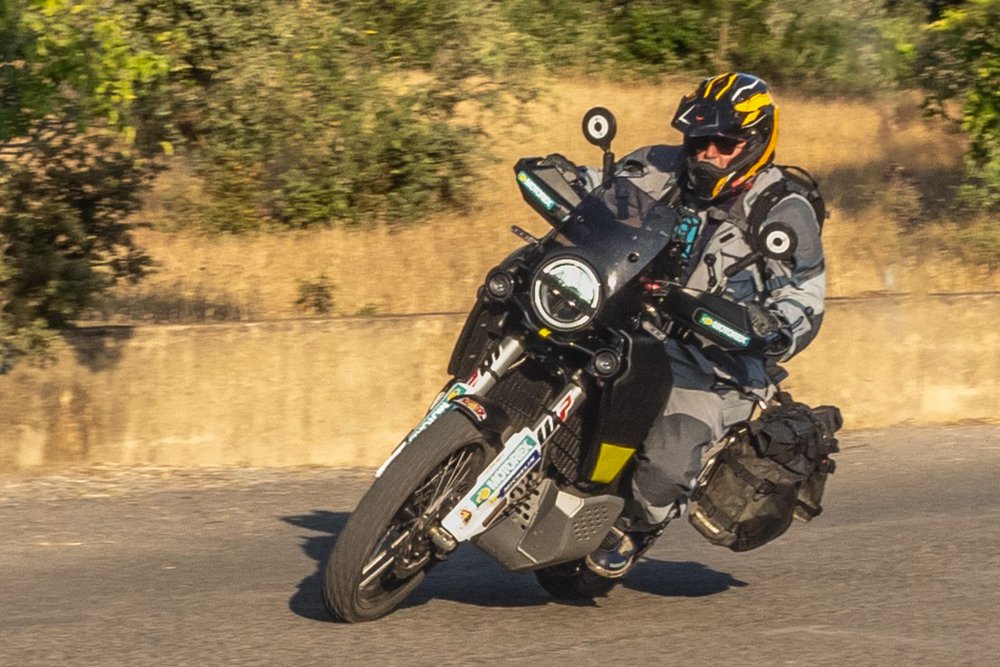
Final Thoughts on the Klim Badlands Pro A3
Wearing this suit on the trails and the road makes me feel invincible – maybe that’s why I had an off! Everything from the D3O armor to the SuperFabric to the zippers and general construction of this suit inspires confidence all around.
The best part about this suit is it melts away when I’m “in the zone” on the bike. The irony about a well-designed piece of gear is that the rider forgets it’s even there. No points to snag or constrain me as I’m cruising in the saddle or up on the pegs climbing a hill. Klim nailed it, not only in comfort and protection, but in flexibility, materials, and construction of these garments.

And if it doesn’t fit you right off the rack, the adjustability in velcro straps, zippers, cinch cords, and kidney belt mean you’ll likely find a perfect fit for you and your riding style as long as the overall fit is generally correct.
If you love what you’ve seen with the Klim Badlands Pro A3 but hesitate at the cost, consider how much your safety and comfort are worth to you, even for occasional rides. If you’re going to spend several thousand dollars every so often to fly and ride in some beautiful rugged terrain, an investment of a small fraction of that in a great suit that will last for many years, even decades, is a fair price to pay. The Klim Badlands Pro A3 is built to last and offers a level of protection and comfort that entirely justifies its price tag.
And should you have a crash, the savings on hospital bills will surely more than make up for the cost of this suit.
This is the most versatile, durable, weather-proof, feature-rich, protective, ventilated dual-sport/adventure suit on the market today. It pushes the boundaries in every way. Pick it up at the links below.
The Klim Badlands Pro A3 has everything you need from an adventure suit: rugged protection, versatility to fit any conditions, comfort for long days, and endless customization. This is the best adventure jacket on the market. | Perfectly suited for any adventure ride, from long hours on the highway to hard enduro in the backwoods. Ride in comfort anywhere from the deserts of Morocco to the jungles of Vietnam. |
The Klim Badlands Pro A3 has everything you need from an adventure suit: rugged protection, versatility to fit any conditions, comfort for long days, and endless customization. This is the best adventure jacket on the market.
Perfectly suited for any adventure ride, from long hours on the highway to hard enduro in the backwoods. Ride in comfort anywhere from the deserts of Morocco to the jungles of Vietnam.
Still not sure the Klim Badlands Pro A3 is for you? Check out the runner-ups for best adventure jackets and pants.
Here’s a list of all the other gear I wore on my 6-week journey across Europe on the Adventure Country Tracks (ACT), pictured throughout this article.
- Helmet: Nexx X.WRL Atika Helmet (until the next X.WRL model comes out, check out the Nexx X.WED3 ADV helmet)
- Boots: Gaerne SG-12 Boots
- Backpack: Klim Arsenal 30 Backpack
- Gloves
- Klim Adventure GTX Short Gloves (Staff Pick at Revzilla)
- Klim Badlands Aero Pro Gloves
- Mid Layers
- Base Layers
For a review of several base layers worn on this trip, check out my Klim Base Layers overview.
Related
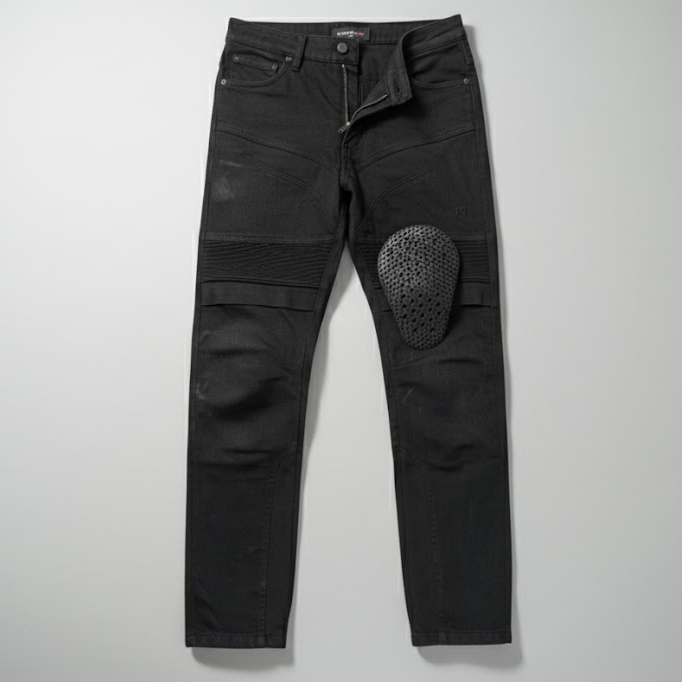
Pando Moto Karldo Jeans Review: Riding Comfort Without Compromise
Riding jeans that actually move with you on the bike, look good off it, and keep you protected. Here's what weeks of testing revealed.

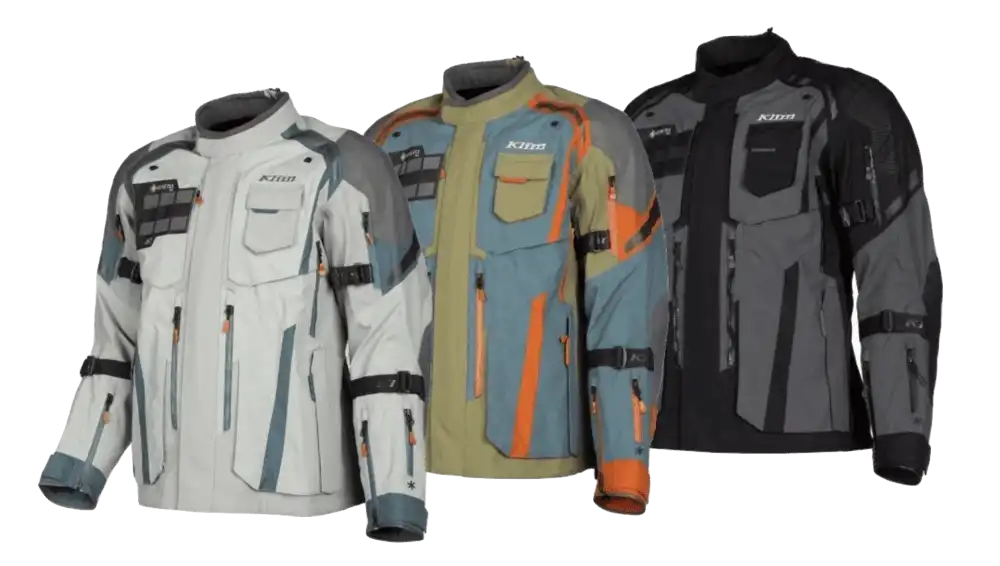
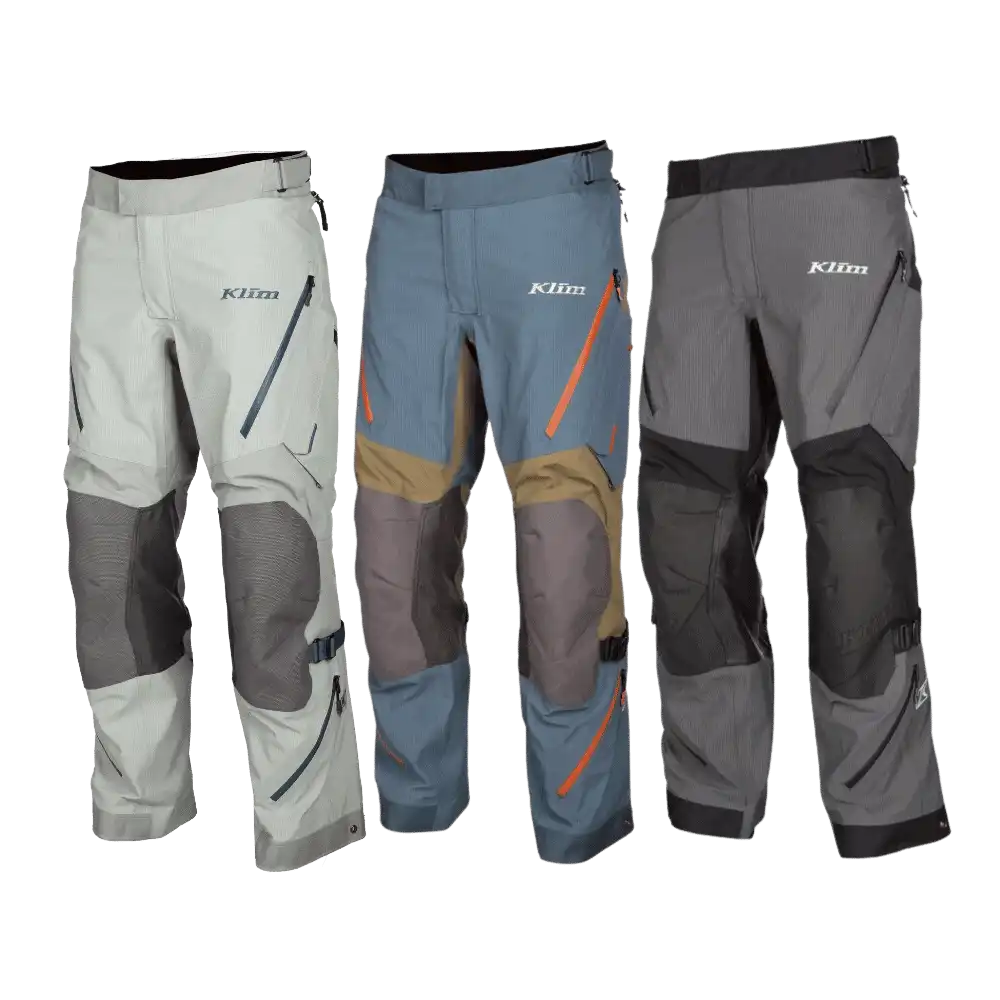


Ricardo Flashman
1 year ago
I feel your review was great, but without a proper hot temperature high humidity test, it seems visually so constricted. I think I’m a Florida summer it might kill me. Previous Klim jackets are notorious for being unusable in hot high humidity environments.
Evan Rally
1 year ago
This is a good point – thankfully JM will be in Thailand soon, so he might be able to bring the suit to test it there in 100F+ with 100% humidity conditions. Out of curiosity, what kind of riding are you doing in Florida that you’d want this suit?
Martin
1 month ago
Thanks for the review! Slowly more CE AAA rated waterproof gear is being made. Would be interesting to compare it with its competitors. LS2 Apollo is another 3 layer laminated AAA adventure suit. No Goretex, but also a lot cheaper than the Badlands A3. And the KTM Terra Adventure Pro is also cheaper and has a removable waterproof liner, so it’s better suited for hot weather.
And there’s the Touratech Campanero Ultimate made by Stadler with with the same 3 layer laminated Goretex as the Klim, but it costs even a little more than the Klim.